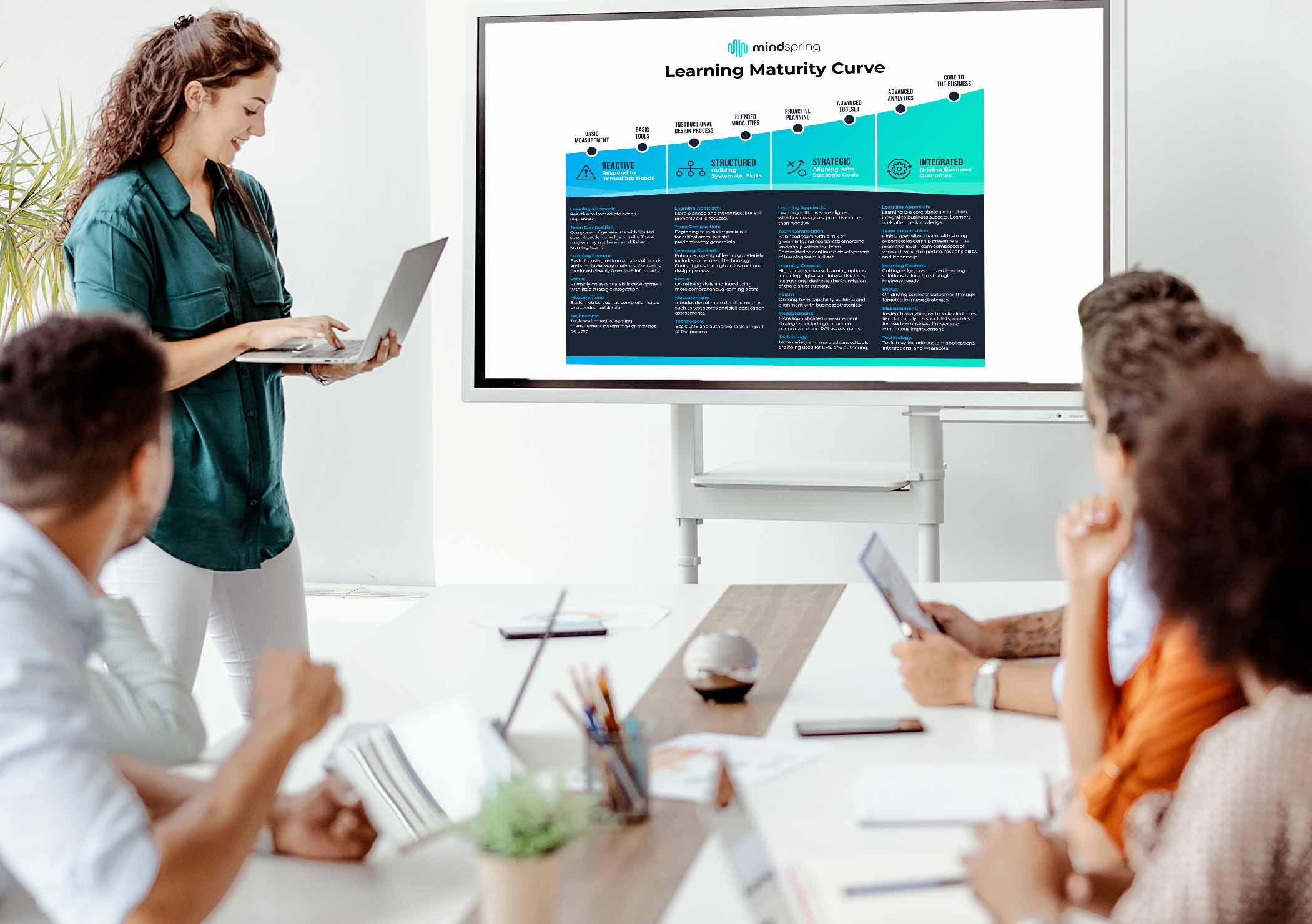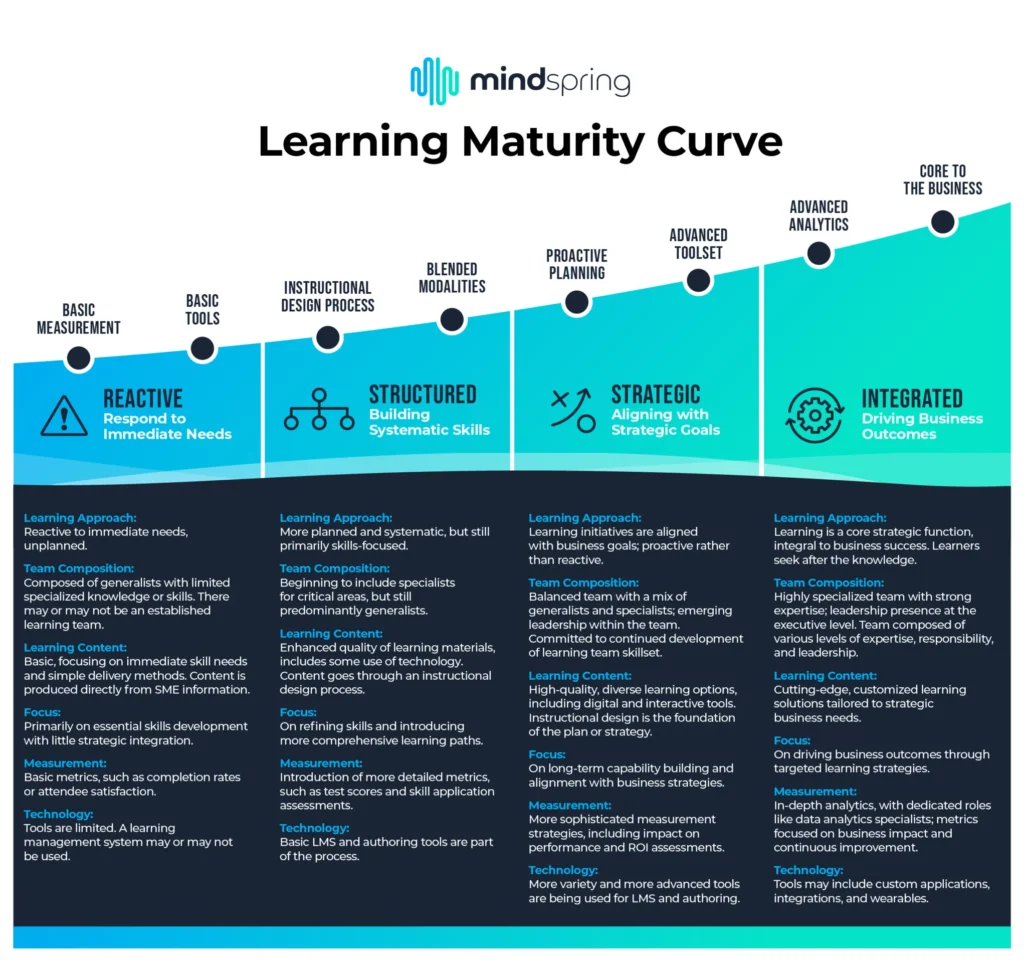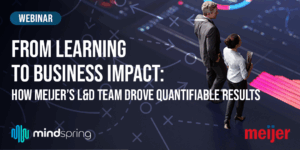
As organizations evolve, the maturity of their learning strategy plays a critical role in driving overall success, competitiveness, and bottom-line results. The journey from a reactive learning approach to a fully integrated, strategic function encompasses several stages, each characterized by distinct features and capabilities. Understanding these stages can help organizations assess their current position and chart a path toward more effective learning and development practices.

Stage 1: Reactive Learning
At the foundational stage, organizations react spontaneously to immediate, perceived training needs. The L&D team, largely composed of generalists, focuses on delivering basic content that addresses immediate skill gaps using simple and direct methods. This stage lacks planning and strategic integration, with measurement focused solely on participant completion rates and basic satisfaction. This also puts the L&D team in the role of order takers and, in practical terms, often leads to the wrong issue being addressed, issues only being addressed at the surface level, or conducting training when the issue should have been solved by other means.
Benefits
The primary benefit of this stage is its flexibility and responsiveness. Organizations can quickly address urgent training needs, which is particularly useful in rapidly changing industries or environments.
Actions in this stage:
Here are some things that can be done in this early stage to begin preparing for the next stage:
- Implement a basic learning management system (LMS) to track and organize learning activities.
- Start gathering data on training efficacy, even if rudimentary, such as learner feedback (Level 1) and immediate post-training knowledge assessments (Level 2).
- Encourage a culture of learning by promoting the benefits and availability of training resources to employees.
Advancing to the next stage:
To move beyond this stage, organizations should start developing a structured learning plan that anticipates future skills requirements rather than just reacting to current needs. This involves:
- Conducting a skills gap analysis (needs assessment) to identify learning priorities.
- Beginning to incorporate learning technologies that enhance delivery and engagement.
- Training or hiring L&D specialists for critical skill areas.
- Finding a trusted partner to help guide progression and best practices.
- Begin to look at learning requests as opportunities to investigate the underlying issues and root causes of the request.
Brief Case Study:
A rapidly growing California startup in the technology sector realized that its leaders lacked onboarding skills needed for an upcoming large, new hire group. The company’s HR generalists quickly organized a series of workshops to address these immediate skill gaps. The outcomes were that 95% of leaders completed the training sessions and 75% rated the training as satisfactory or higher. While the workshops were somewhat effective in addressing the short-term needs, the reactive nature of the approach led to repeated ad-hoc training sessions, misaligned processes, and the spread of misinformation to the new hire group.
Stage 2: Structured Learning
This stage introduces more systematic learning processes, with plans that are developed in advance and focused on broader skills development. The L&D team still includes many generalists but starts to integrate specialists who can develop more sophisticated training programs. The content quality improves – and is based more on real needs, technology is utilized to create more engaging and effective learning experiences, and more training impact is realized due to root cause resolution. Measurements extend beyond simple metrics to include assessments of skill application and learning effectiveness (Level 3).
Benefits:
Structured learning leads to more consistent training outcomes and begins to build a foundation for aligning learning with organizational goals. It reduces redundant or ineffective training efforts and starts to address the broader development needs of the organization. It also begins to lay the groundwork for the L&D team to be seen as business partners.
Actions in this stage:
- Standardize training processes and materials to ensure consistency across the organization.
- Begin to develop a competency framework that aligns with business goals.
- Explore and implement more sophisticated learning technologies.
- Begin gathering real-life learning data.
Advancing to the next stage:
- Align learning initiatives with business objectives to demonstrate the value of training.
- Diversify learning methods to include modern, interactive, and digital tools.
- Develop leadership within the learning team to advocate for strategic learning practices.
- Begin presenting learning data (Levels 1 – 3) to the leadership team.
Brief Case Study:
A national retail chain in Tennessee recognized the need for implementing a Learning Management System (LMS) to standardize training processes and materials across its stores. The L&D team, including some online instructional designers, developed a competency framework aligned with business goals and introduced sophisticated training programs using e-learning modules. The outcomes were that 90% of stores followed standardized training protocols, 80% of employees were assessed against the new competency framework within the first year, and customer satisfaction scores increased by 15% within six months of implementing the structured learning approach. The structured approach led to more consistent training outcomes, reduced redundant training efforts, and began to build a foundation for aligning learning with organizational objectives.
Stage 3: Strategic Learning
Learning in this stage is proactive and aligned with the organization’s strategic goals. The learning team balances generalists and specialists with emerging leaders who integrate learning into the broader business strategy. The focus shifts from individual skill development to long-term capability building. Measurement strategies are sophisticated, evaluating the impact on performance (Level 4) and the return on investment (ROI) of learning programs.
Benefits:
Strategic learning enhances the organization’s ability to plan for the future, adapt to changes, and ensure that all training investments contribute directly to business objectives. It fosters a culture of continuous improvement and learning, and begins the process of becoming trusted business partners, solving business issues.
Actions in this stage:
- Foster strong collaboration between the L&D team and other business units to ensure learning initiatives support overall business goals.
- Utilize data-driven decision-making to tailor learning programs to the specific needs of the workforce and the organization.
- Encourage leaders to champion learning initiatives and integrate them into their team’s objectives.
Advancing to the next stage:
To achieve the highest level of learning maturity, organizations should:
- Establish learning as a key element within the business strategy.
- Integrate learning outcomes with business performance metrics.
- Foster a culture where learning and development are valued at all levels of the organization by integrating learning into all business systems.
- Begin to “market” the training results and outcomes that are being achieved.
Brief Case Study:
A financial services firm in Michigan aimed to proactively align its learning initiatives with its strategic goals. The firm’s dedicated L&D team focused on long-term capability building and used data-driven decision-making to tailor learning programs. Measurement strategies included evaluating the impact on performance (Levels 1 – 4) and return on investment (ROI) of learning programs. The outcomes were that 85% of training programs were directly aligned with strategic business objectives, 70% of employees demonstrated improved long-term capabilities within one year, and the firm saw a 20% increase in ROI from learning initiatives, with a significant impact on employee retention (10% increase). The strategic learning approach enhanced the firm’s ability to plan for future challenges and adapt to industry changes. Training investments were directly linked to business objectives, fostering a culture of continuous improvement and learning.
Stage 4: Integrated Learning
At this highest level, learning is an integral, strategic function of the organization – and is a primary driver of continuous improvement. The team is highly specialized, with strong leadership representation at the executive level. Learning strategies are tailored to drive specific business outcomes, and the content is cutting-edge and fully customized. L&D professionals are seen as valued business partners, drive much of the improvements across the organization, and are involved in organizational development activities such as mergers and acquisitions, cost containment, business restructuring, etc. Measurement focuses on detailed analytics and real business impact to KPIs, with continuous improvement mechanisms in place to drive toward the future business needs.
Benefits:
An integrated learning program maximizes the strategic impact of learning on business success. It supports the organization’s agility and resilience, enabling rapid adaptation to new challenges and opportunities.
Continual improvement:
- Continually innovate and adapt learning strategies to keep pace with changes in the business environment and technology.
- Develop metrics that directly correlate learning outcomes with business performance to continually demonstrate the value of L&D.
- Foster a culture where continuous improvement in learning practices is valued and expected.
- Drive a culture of being prepared for the future.
Brief Case Study:
A global manufacturing company in North Carolina achieved the highest level of learning strategy maturity by fully integrating learning into its business strategy. The L&D team developed annual customized learning strategies tailored to drive specific business outcomes. They used advanced analytics to measure not only learning outcomes but the real business impact on key performance indicators (KPIs) and continuously innovated their learning practices. The outcomes were that 90% of learning initiatives had executive-level sponsorship and involvement, 95% of training programs were focused on business needs, and they saw a 20% reduction in production downtime and a 30% increase in safety compliance – it also resulted in a cost savings of over $100K. The integrated learning program maximized the strategic impact on business success, enabling the company to rapidly adapt to new challenges and opportunities. The organization’s agility and resilience improved, and the L&D team drove strategic, business results.
Navigating through these stages from reactive to integrated learning strategy is a transformative process that can significantly impact an organization’s success and requires a strategic vision for corporate learning that encompasses not only the current needs but also anticipates future challenges. By understanding and progressing through the stages of learning strategy maturity, organizations can better align their learning and development efforts with their overall business objectives. The real-life case studies demonstrate the tangible benefits and measurable outcomes at each stage, from immediate skill gap closures to strategic alignment and significant business performance improvements.
For organizations seeking to assess their current learning strategy or to advance to the next stage of maturity, partnering with MindSpring can provide the expert guidance and support needed to advance. We specialize in helping businesses understand their position on the learning maturity curve and develop customized strategies to enhance learning effectiveness and align it closely with business goals. By collaborating with us, you can leverage our expertise in learning strategy, learning experiences, and learning technology to not only meet your immediate training needs but also to build a robust learning environment that propels your organization forward in today’s competitive landscape. Whether you are starting from a reactive stage or aiming for a fully integrated approach, MindSpring is equipped to support you at every step of your learning journey, ensuring your learning initiatives are both strategic and impactful.


